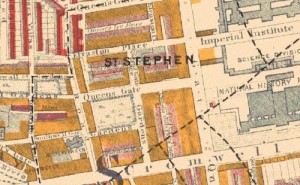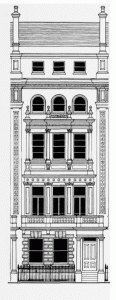Queen’s Gate, as mentioned in Romance of a Shop, is a residential area “adjacent to Kensington Gardens and near the Royal Albert Hall” (Levy Chapter 2 footnote 1). The street was built on a Land brought by The Royal Commissioners which explains why this area contained mostly groups of people from high middle to wealthy class (Charles Booth).
 The Queen’s Gate area was described by Halsey Ricardo as “something striking by the hand of an architect, and something humdrum by the unaided hand of the builder”(Survey of London: Volume 38, South Kensington Museums Area), before its revival period. During the Victorian Area, most of the buildings looked the same and the East side of Queen’s Gate was a clear representation of that. Later on, Norman Shawn’s architectural design contribute to Queen’s Gate revival period (Survey of London: Volume 38, South Kensington Museums Area).
The Queen’s Gate area was described by Halsey Ricardo as “something striking by the hand of an architect, and something humdrum by the unaided hand of the builder”(Survey of London: Volume 38, South Kensington Museums Area), before its revival period. During the Victorian Area, most of the buildings looked the same and the East side of Queen’s Gate was a clear representation of that. Later on, Norman Shawn’s architectural design contribute to Queen’s Gate revival period (Survey of London: Volume 38, South Kensington Museums Area).
In Romance of a shop, Constance Devonshire lived in Queen’s Gate with her family where Gertrude was staying. Constance, also known as Conny, was described by Levy as a “blooming young woman, dressed in the height of fashion” (Chapter 2). In her first introduction to the story, Constance is described as a high class social woman, with elegance in her presence and her style. Her brother Fred is also described as a “a tall, heavy young man, elaborately and correctly dressed, with a fatuous, good-natured, pink and white face” (chapter 2). She is well off, which explains why her character would be located here. Conny even offers Gertrude to stay with her while she gets back on her feet after the death of her father.
Conny, although rich, does not seem to express happiness. When Gertrude tells her about how she plans on getting back on her feet, Conny replies, “Sounds very nice,’ she added with a sigh, and thought perhaps, of her own prosperous boredom” (Chapter 2). Although she is much better off than the Lorimer sisters, she seems to be un-amused with her own world.
Conny is a representation of life for women who were not actively seeking to become the new women. Although she is financially well, she is not satisfied with her life. She finds interest in the Lorimer sisters and much of the reason could be because these are women who are working for their money, rather than just having it.
Work cited
‘Buildings of the Domestic Revival and later.’ Survey of London: Volume 38, South Kensington Museums Area. Ed. F H W Sheppard. London: London County Council, 1975. 325-348. British History Online. Web. 15 December 2015. http://www.british-history.ac.uk/survey-london/vol38/pp325-348.
Weinreb, Ben and Hibbert, Christopher (1992). The London Encyclopedia (reprint ed.). Macmillan. p. 650.

